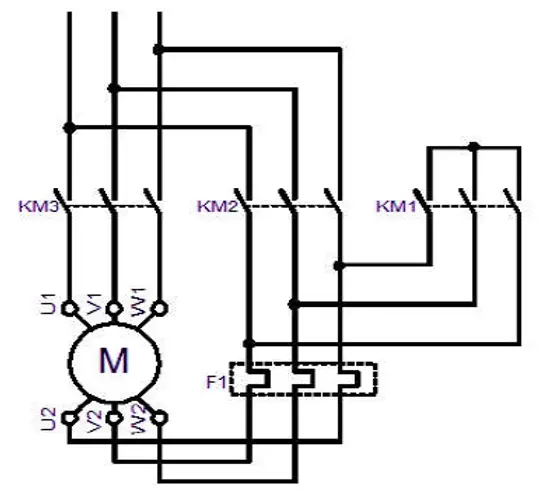This article describes the troubleshooting of the star-delta starter. Star Delta starters are widely used in electrical installation for starting large-rating squirrel cage induction motors to limit the starting current of the motor. Every electrician and engineer must know about the probable problems that frequently occur in the starter or motor connected to it. We will discuss all the problems related to star delta starter in this post. First, let us list the problems.
- Motor takes high current at start and trips
- The motor keeps on running in Star and does not come in delta.
- The fuses get blown during the changeover from star to delta
- A motor over-current trip during star-to-delta changeover
- Motor current hunting
Now, Let us discuss all the reasons in detail, their causes, and solutions. The circuit diagram of the star delta starter is as follows.

KM1 – STAR CONTACTOR
KM2 – DELTA CONTACTOR
KM3 – MAIN CONTACTOR
The following points need to be checked for troubleshooting of Star-Delta Starter.
Motor takes high current at starts and trips
Generally, the squirrel cage induction motor draws 5 to 7 times the current of its full load current(FLC) when we start it from the rest position. If the overload relay trips the main contactor during motor running in a star configuration, the overload relay setting must be checked. If the relay setting is correct, check the trip class of the relay. If the motor is driving a fan, then the trip class setting of the relay must be 25 to 30.
Also, Check the following to ensure that there is no single phasing.
- Main Contactor – Check the power contacts and Aux. contact
- Star Contactor – Check the power contacts and auxiliary contacts
- Motor Cable – All six cores of the motor should be checked
- Motor winding – Check the winding resistance
Motor Keeps on Running in Star and does not come in Delta
The timer is used in the star delta starter to do a changeover from star to delta. If the timer is defective, the motor will keep running in star mode if the load permits. Here, load permits mean if the torque requirement is less, then the motor may keep on running else. The motor will trip with overload if the load demands more torque. Note that the motor in star mode delivers only 58.7 % of the motor’s rated torque.
Fuses get blown during star-to-delta changeover
This is a very interesting problem. One may come across this problem when the existing faulty motor is replaced. One must check the proper configuration of the delta connection formed in the starter or feeder of the newly installed motor. The proper delta may be checked by measuring the inductance of the motor. The inductance of all three phases will be balanced if the winding is correctly connected in the delta.
If the delta is not correctly formed, the line-to-line short circuit will take place at the instant when the motor winding configuration is changed from star to delta. Though there may be many reasons for the short circuit and blowing of fuses, this is one of the reasons for the blowing of fuses during star-to-delta changeover.
Motor over-current trip during star-to-delta changeover
It is important to set the timing of the timer correctly. When the motor starts accelerating in the star, its current decreases as the motor speeds up. However, it is only possible if the load on the motor is less compared to the motor’s torque-delivering capacity. When the motor is changed from star to delta, the motor may draw a high current if it has not attained sufficient speed when running in a star. Therefore, according to load and motor speed torque characteristics, the timing of the timer must be set to have a minimum current shift during the transition from star to delta.
Motor Current Hunting
If the fluctuation in motor current is observed, the motor must be immediately stopped if the protection relay does not have a negative sequence protection element(I2). The motor current hunts when there is a loose connection in the rotor or single phasing. Single phasing is the extreme case of a negative phase sequence. The negative phase sequence current produces counter torque in the motor, and the winding starts heating up and eventually leads to insulation failure. The following must be checked if hunting in the motor current is observed.
- Motor winding
- Delta connection circuit- Main contactor and delta contactor
- Cable
This is all about troubleshooting the star-delta starter.